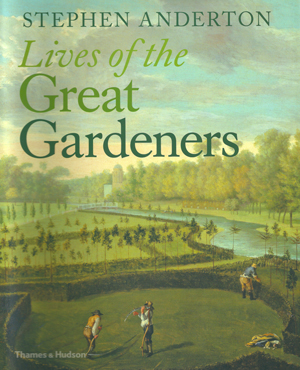Lives of the Great Gardeners
History is full of gardens and of great garden designers – “plantsmen, lovers of intellectual ideas, of geometry or nature’s sinuous curves” – points out Stephen Anderton in his new book ‘Lives of the Great Gardeners’.
He also points out that their work, like that of the great painters, is completely international knowing no language barriers and appealing as much to visitors from different cultures as to the person next door.
So it is fitting that in his latest book, Stephen features 40 gardeners from 13 countries, showcasing 500 years of gardening tradition. From the famous Red Books of Humphrey Repton (1752-1818) to the freer, vigorous and vivacious work of Roberto Burle Marx (1909-1994), he takes us on a gardening exploration of ideas, concepts and trends that have in turn influenced us today.
What they all have in common, no matter where they were born, is the ability to take an idea and develop it in a new manner relevant to their times, and thus create some of the world’s most exciting gardens.
From the politically allusive gardens of 18th century England where men such as William Kent practiced their art to the sweeping prairie-style projects of Piet Oudolf, the author examines the lives of these 40 gardeners and how often their backgrounds influenced their art and work.
The author divides his gardening subjects into four distinct areas – Gardens of Ideas, Gardens of Straight Lines, Gardens of Curves and Gardens of Plantsmanship, – within which he places his 40 gardeners according to their style.
 Included in Gardens of Ideas we find such names as Wen Zhengming, William Kent, Charles Jencks and Thomas Jefferson. In Gardens of Straight Lines we come to designers such as Sir Edward Lutyens and Lawrence Johnson. In Gardens of Curves we find Humphrey Repton, Lancelot Brown, Alan Bloom and John Brooks while Gardens of Plantmanship contains such names as Claude Monet, Gertrude Jekyll and Rosemary Verey.
Included in Gardens of Ideas we find such names as Wen Zhengming, William Kent, Charles Jencks and Thomas Jefferson. In Gardens of Straight Lines we come to designers such as Sir Edward Lutyens and Lawrence Johnson. In Gardens of Curves we find Humphrey Repton, Lancelot Brown, Alan Bloom and John Brooks while Gardens of Plantmanship contains such names as Claude Monet, Gertrude Jekyll and Rosemary Verey.
Of course the term ‘great gardeners’ is somewhat subjective and there are always many arguments among gardeners and garden historians as to the deserving of such a title. No doubt there are some who would point out that the author should have included this or that designer, however, overall I think Stephen Anderton has chosen well.
For each designer we are given their date of birth and death (where applicable) with world events, setting the gardener in his or her time context which I found helpful.
The book contains a wide range of images of gardens as they were originally seen and as they are today, together with portraits of their makers and with a lively and entertaining text by award-winning garden writer Stephen Anderton, I found the book appealing and interesting.
The author is a journalist, author, lecturer and broadcaster and is best known as The Times’ long standing writer on gardens and gardening. He worked for many years on the care and restoration of historic gardens and this comes to the fore in his clear interpretation of the gardens included in the book and their creators.
His acclaimed biography: ‘Christopher Lloyd: His Life at Great Dixter’ is one of my favourite books and I am more than delighted to add ‘Lives of the Great Gardeners’ to my bookshelf. I think the author has created a neat and compact overview of some of the world’s most influential garden designers and gardeners to give the reader a precise insight into their work and their influence on gardens and gardeners throughout the last 500 years.
‘Lives of the Great Gardeners’ by Stephen Anderton is published by Thames & Hudson, in hardback at £24.95. www.thameshudson.com
The book is due for release on 20th October, 2016.


